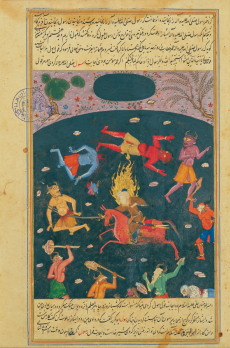
Jinn—romanised as djinn or anglicised as genies—are supernatural creatures in Islamic mythology and theology. They are mentioned frequently in the Quran and other Islamic texts, but there is also evidence that Arabs worshipped jinn hundreds of years before Islam. In the Islamic tradition angels, humans and jinn are the three sapient, intelligent creations of Allah. An individual member of the jinn—known as a jinni, djinni or genie—can be good or evil, and have free will like humans do.
According to the Quran jinn are made of a smokeless and “scorching fire”, while humans are made of clay. After Allah made the first human, Adam, he commanded the angels and jinn to bow to him. One of the jinn, called Iblis, refused out of pride, insisting that because he was made of fire he would not bow to a creature made of clay. Allah punished him for his insolence, banishing him from Jannah (heaven) and calling him Shaytān (Satan).
The jinn inhabit an invisible world beyond the known universe, and don’t usually appear to humans. We are visible to them, however, and jinn can interact physically with both people and objects in our world. Sometimes they choose to manifest themselves either in animal or human form, generally to trick or destroy human victims. According to the influential late medieval Islamic theologian Ibn Taymiyyah, jinn are treacherous and untruthful creatures, responsible for mischief and magic in the human world. For example, they collaborate with magicians to make objects float in the air, tell prophesies to fortune-tellers and speak with the voices of the dead to spirit mediums. Some, but not all, Muslims believe that each person is assigned their own jinni, called a qarīn or ‘constant companion’. The qarīn urges people to do evil, and to disobey Allah. Only Muhammad’s qarīn didn’t do so, and converted to Islam instead.

Besides causing mischief in the human world, the jinn live much like people do. They live in communities in remote areas, like mountains, seas, forests and in the air. Their social organisation is also like ours, with kings, laws and courts, weddings and funerals.
Archaeological evidence from Arabia suggests that jinn may have been worshipped for hundreds of years before Islam. An Arabic inscription found near the ruined city of Palmyra in modern Syria pays tribute to the ‘ginnaye’ or ‘good and rewarding gods’, arguably a term related to jinn. Now they are a common part of the local folklore in various Muslim cultures around the world. Besides the Qu’ran, other stories of the jinn can be found in the One Thousand and One Nights. In one tale called "The Porter and the Young Girls" a young prince seeks finds an underground chamber in the forest, in which there is a beautiful woman kidnapped by an ifrit. Ifrit are a type of jinn who appear as enormous winged creatures made of fire. The ifrit attacks the prince and transforms him into an ape, but a princess arrives and battles with the jinn (pictured), eventually reducing it to cinders.
Images: https://upload.wikimedia.org/wikipedia/en/4/4f/Imam_Ali_and_the_Jinn.jpg https://upload.wikimedia.org/wikipedia/commons/a/aa/A_Princess_burns_the_Ifrit.jpg

0 Comment:
Be the first one to comment on this article.